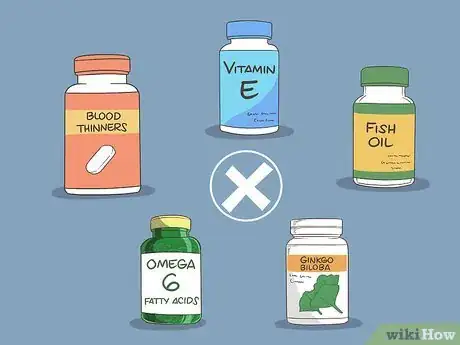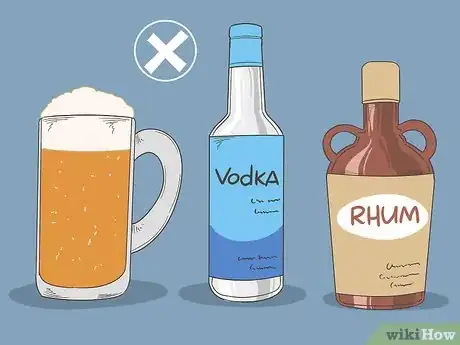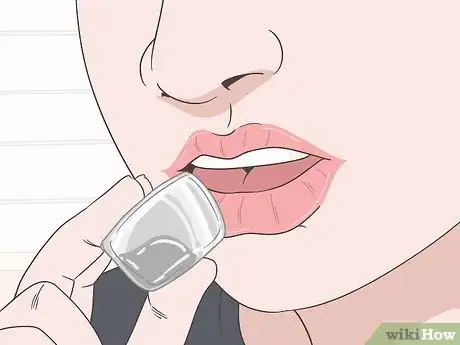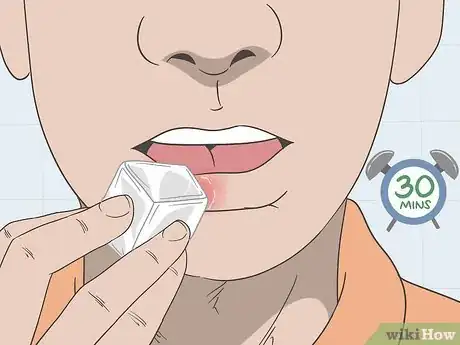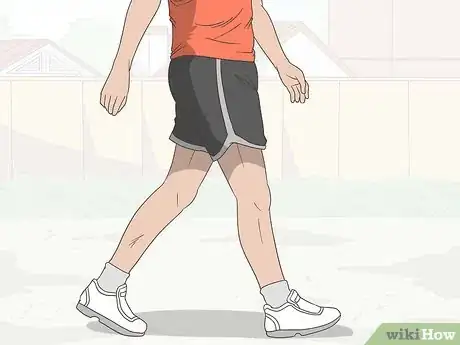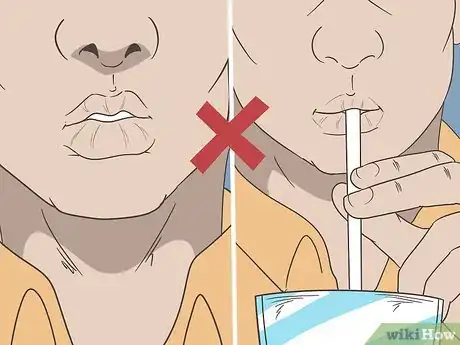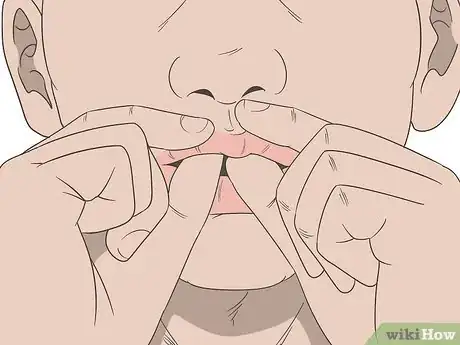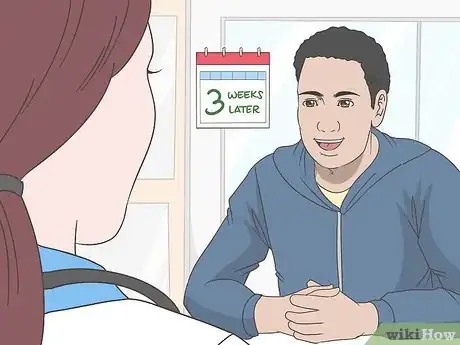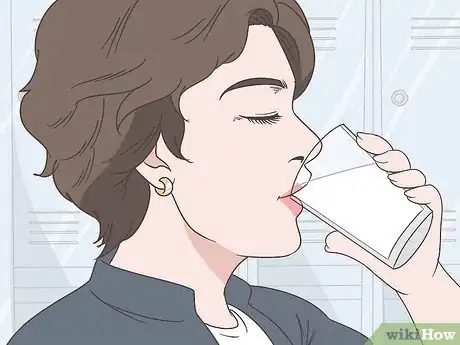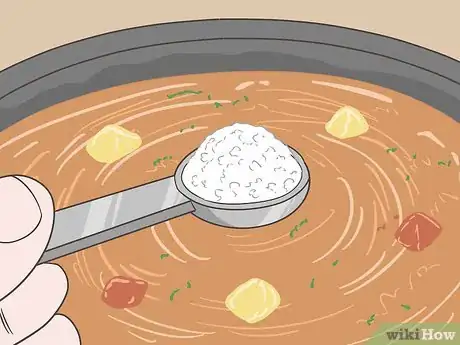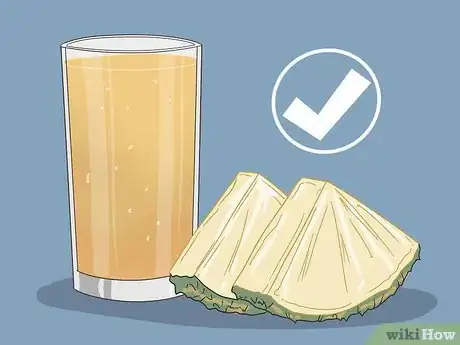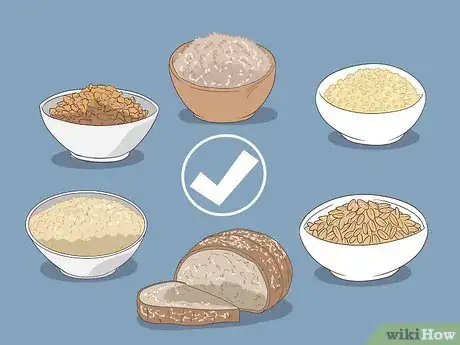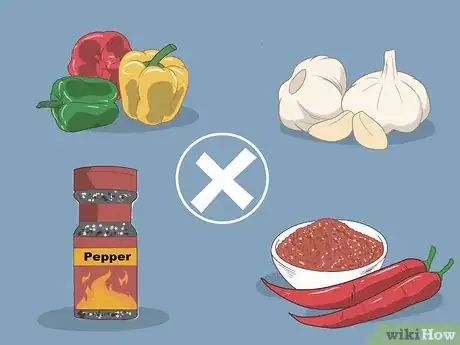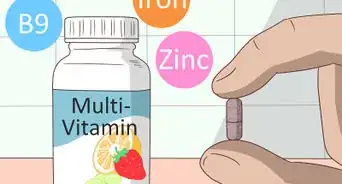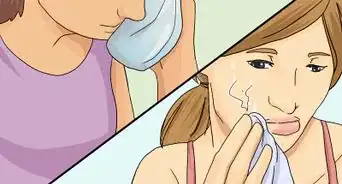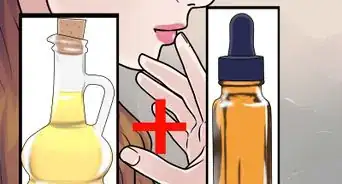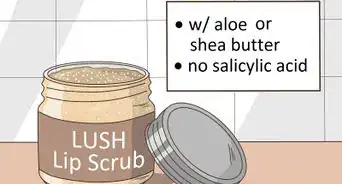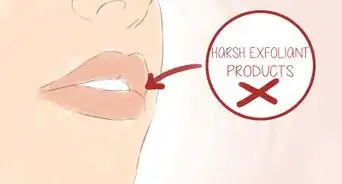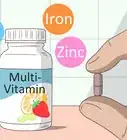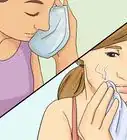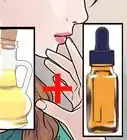This article was medically reviewed by Luba Lee, FNP-BC, MS. Luba Lee, FNP-BC is a Board-Certified Family Nurse Practitioner (FNP) and educator in Tennessee with over a decade of clinical experience. Luba has certifications in Pediatric Advanced Life Support (PALS), Emergency Medicine, Advanced Cardiac Life Support (ACLS), Team Building, and Critical Care Nursing. She received her Master of Science in Nursing (MSN) from the University of Tennessee in 2006.
There are 23 references cited in this article, which can be found at the bottom of the page.
This article has been viewed 14,491 times.
It's normal to experience some degree of swelling for a few days after getting lip injections. In most cases, any swelling won’t be very noticeable after a few days. And even if you notice it, it’s unlikely that other people will. Your doctor will give you instructions on how to care for your lips after the treatment that will help the swelling go down as soon as possible. There are also a few things you can do before your appointment to make your lips heal faster. With the right preparation and aftercare, you can show off your plush new pout sooner than you think!
Steps
Preparing for the Treatment
-
1Don't take blood thinners or NSAIDs 7 days before or after your appointment. Avoid aspirin, ibuprofen, and naproxen for a week before and a week after the procedure because they can thin your blood and increase the risk of bruising. Most people don’t experience any bruising but if you do, it’s usually mild and will go away in a day or two. If you take a prescription blood thinner (like Warfarin), talk to your general practitioner about what you should do leading up to your treatment and during the healing process.[1]
- You should also avoid taking herbal supplements like vitamin E, fish oil, omega-3 fatty acids, garlic, gingko biloba, St. John's wort, ginseng, and primrose oil 7 days before or after your appointment because they can act as blood thinners.
- Cranberry juice can also act as a natural blood thinner, so steer clear of it in the days before and after your appointment.[2]
-
2Avoid drinking alcohol 24 hours before your treatment. Alcohol thins your blood, which increases the risk of bruising around your lips. Any bruising that does happen is usually mild and hardly noticeable, so don’t worry if you do notice small bluish spots for the first 1 or 2 days. Focus on staying hydrated with water, decaffeinated tea, and natural fruit juices (aside from cranberry juice) instead.[3]
- Alcohol also dehydrates you, which can make your face look slightly bloated.
Advertisement -
3Take arnica pills 2 days before your treatment. Follow the directions on the label, taking 1 or 2 pills a day or dissolving 5 sublingual pellets under your tongue 3 times a day. Arnica is a natural herb that will help your lips settle down into their new beautiful shape faster.[4]
- If you take blood thinners, talk to your doctor before taking arnica pills.
- You can buy arnica without a prescription at any pharmacy or natural health store.
- You can also get arnica in a topical gel. Some people report that massaging the gel into their lips an hour before getting an injection helps prevent swelling and bruising.
-
4Ice your lips right before the injection to reduce bruising and swelling. Before you get your injection, ask the doctor or nurse doing the procedure if you can have an ice pack. Apply it to your lips for a few minutes or as long as they recommend to prepare your lips for the injection. The cooling effect will help the muscles and tissue in and around your lips relax so there’s less swelling afterward.[5]
- Don’t apply ice directly to your lips because the direct cold could irritate your skin. The doctor or nurse will probably give you a paper towel or other covering to put over the ice pack.
-
5Tell your physician if you regularly get cold sores. The holes where the needles go into your lips could cause cold sores to flare up, so talk to your doctor if you're concerned about an outbreak. Odds are, it won’t be an issue, but your doctor may recommend taking antiviral medication the morning of your appointment to prevent a flare-up.[6]
- If you have a cold sore the day of your appointment, reschedule to a later time so the cold sore can heal.
Following Home Care Instructions
-
1Apply ice to your lips for 5 to 10 minutes 3 times a day or as needed. The nurse will likely give you an ice pack or compress right after the treatment to place on your lips. Once you're home, wrap an ice pack or bag of ice in a thin towel and hold it onto your lips for 5 to 10 minutes at a time. Do this up to 3 times a day or as needed.[7]
- If you feel self-conscious about the extra swelling, ice your lips right before going out to get rid of any extra puffiness.
- Don't hold ice directly onto your lips because the cold ice can freeze-burn the sensitive skin on and around your lips.
-
2Avoid exercising for 24 hours after your treatment. Take it easy for a day to avoid increasing the amount of blood flowing to your lips. Light, easy walks are okay, but don't do anything that gets your heart pumping or causes you to sweat.[8]
- During the first 24 hours, the filler will be absorbing water from your own tissues and acclimating to the muscles in your face. Exercise can cause this process to happen faster than it would otherwise, increasing the chance of bruising or long-term swelling.
- Sweat also carries a lot of bacteria, which can plug up the injection sites and cause an infection.
-
3Refrain from pursing your lips or sucking on straws for 24 hours. Moving your lips into kissing or sucking positions can affect how the filler material sits in your lips. Jostling or misshaping the filler is the last thing you want to do because it can cause the swelling to last longer. Try to relax your lips when you speak, eat, and drink to keep your new pout in tip-top shape.[9]
- This means drinking through straws, smoking cigarettes, whistling, and taking kissy-face selfies are off-limits for at least 24 hours.
-
4Stay away from excessive heat for the next 2 days. Hot showers, hot yoga, hot tubs, steam rooms, and saunas are all off-limits for 2 days after your treatment. Heat increases blood flow to the area, which can exacerbate the swelling. Instead, relax in a warm or lukewarm tub or shower. If the water lets off steam then you know it’s too hot.[10]
- If it's hot outside to the point where you might sweat, stay indoors in the air conditioning.
-
5Do not rub or massage your lips for 48 hours post-treatment. Massaging your lips before they have fully settled can cause them to migrate or shift. The only person that should be massaging your lips is your physician, who may do so if you notice any developing lumps within a few days after your lip filler treatment.[11]
- Also be careful not to bite your lip while eating to avoid migration.
- Be gentle while washing your face and applying lip balm.
-
6Keep your head elevated above your heart for 48 hours after your treatment. Rest your head on 2 to 3 pillows at night so your head stays above your torso while you sleep. The idea is to decrease blood flow to the area so the lip filler can gently settle into your muscle tissue. If you have trouble getting to sleep while you’re propped up, it’s okay to remove 1 of the pillows, just make sure your head isn’t flat on the bed.[12]
- It's okay to temporarily bend down when you need to, but don't lower your head below your heart for long periods of time.
-
7Book a follow-up appointment with your doctor 2 to 3 weeks later. Plan to see your doctor 2 to 3 weeks after your initial appointment so they can check on how your lips are coming along. Tell them about anything you may have experienced in the last few weeks regarding your lips. From slight tingling sensations to redness, bumps, or small bruises—let them know. Most of the time, these things are a natural part of the process.[13]
- While it’s rare to have an allergic reaction to lip fillers, you should let your doctor know if you’ve experienced any itching, blistering, peeling, or developing rashes.[14]
Eating to Decrease Swelling
-
1Drink around 11 cups (2,600 mL) of water each day to stay hydrated. Drink 11 cups (2,600 mL) to 15 cups (3,500 mL) of water per day to stay hydrated and set yourself up for a speedy recovery. You can find your daily recommended amount by dividing your weight (in pounds) by 2. The result is how many ounces you should drink each day.[15]
- For example, if you weigh 140 pounds (64 kg), aim to drink 70 fluid ounces (2,100 mL) of water every day.
- Limit or avoid caffeinated or alcoholic drinks like coffee, black tea, wine, spirits, and beer because they can cause dehydration and water retention.
-
2Limit your sodium intake to less than 1 tsp (2.1 to 4.2 g). Cook only with a small pinch of salt and resist the urge to salt your food at the table. Too much salt can make you bloat, which will only add to the swelling in your lips. However, any added swelling from bloatedness won’t be drastic and odds are, other people won’t even notice.[16]
- Read the labels on frozen foods, canned vegetables, condiments, and dressings because some varieties have lots of sodium.
- Skip the drive-through or popular chain restaurants and cook at home using whole foods as often as you can.
- The recommended daily amount of sodium per day is 2,300 mg, which is equal to 1 tsp (4.2 g). However, your body can function with as little as 500 mg per day so it’s okay to withhold salt for the first 2 to 3 days of your recovery if you’re prone to bloating after salty meals.
-
3Have some pineapple to help reduce swelling and bruising. Pineapples contain a compound called bromelain that promotes other enzymes in your body to let go of extra water. Snack on pineapple chunks or drink pineapple juice after your appointment to reap the anti-inflammatory benefits.[17]
- The bromelain in pineapple can also act like a mild, natural painkiller.
-
4Eat antioxidant-rich fruits and vegetables to speed up your recovery. Red grapes, blueberries, strawberries, raspberries, goji berries, pomegranate, dark leafy greens, and sweet potatoes contain nutrients that fight off free radicals, reducing inflammation throughout your body. Your immune system will also get a boost from the vitamin C and zinc, helping the fillers acclimate to your lip muscles with ease. The better the filler acclimates, the more natural your plump new pout will look.[18]
- If you plan to make a smoothie containing lots of antioxidant-rich fruits, remember to avoid drinking it out of a straw for the first 24 hours after your treatment.
-
5Swap trans fats for healthy oils and nuts to fight inflammation. Trans fats raise unhealthy (LDL) cholesterol and promote inflammation in your body. It’s unlikely you’ll notice much of a difference in your lips, but it’s best to stick to healthy, anti-inflammatory fats so you can look and feel your best sooner. Instead of cooking with butter and lard, use olive, canola, coconut, grapeseed, or avocado oil in your dishes.[19]
- Nuts like almonds, walnuts, cashews, pistachios, and pecans also contain omega 3 and omega 6 fatty acids, which help your body make more tissue-healing white blood cells.
- Whole milk, cheese, ice cream, and red meat also contain trans fats, so stay away from dairy and meat until your lips are healed.
-
6Choose whole grains over refined carbohydrates to help relieve swelling. Eating lots of refined grains can make your blood sugar spike, which leads to water retention and, in turn, bloating and inflammation. Instead of white rice, white bread, and regular pasta, opt for brown or black rice and whole-grain wheat varieties of bread and pasta. The fiber in whole grains can promote healing, which means you can show off your new pout sooner![20]
- Oats, quinoa, millet, barley, buckwheat, farro, and sorghum are all great ways to load up on whole grains and fiber without the inflammatory effects.
-
7Don't eat spicy foods to avoid irritating your lips. Capsaicin in spicy foods like hot sauce, spicy peppers, and cayenne can irritate your lips, which is not helpful if they’re already a bit sensitive and swollen. Black pepper is okay, just lay off the hot sauce for 5 to 7 days after your appointment.[21]
- Capsaicin (the compound that makes spicy foods taste so hot) increases the amount of heat your body produces. While your lips are healing, it’s best to avoid unnecessarily raising your body temperature.
Warnings
- Call your doctor if you experience any itching, blistering, or redness after your treatment.[26]⧼thumbs_response⧽
References
- ↑ https://www.ncbi.nlm.nih.gov/pmc/articles/PMC3760599/
- ↑ http://pennstatehershey.adam.com/content.aspx?productid=107&pid=33&gid=000235
- ↑ https://www.alcohol.org/effects/thin-blood/
- ↑ https://www.ncbi.nlm.nih.gov/pmc/articles/PMC539394/
- ↑ https://www.ncbi.nlm.nih.gov/pmc/articles/PMC2890129/
- ↑ https://aestheticsjournal.com/feature/case-study-lip-filler-complication
- ↑ https://www.ncbi.nlm.nih.gov/pmc/articles/PMC5300735/
- ↑ https://www.ncbi.nlm.nih.gov/pmc/articles/PMC3865975/
- ↑ https://www.irwindentalcenter.com/docs/POST-TREATMENT-INSTRUCTIONS-Dermal-Fillers.pdf
- ↑ https://www.ncbi.nlm.nih.gov/pmc/articles/PMC2890129/
- ↑ https://www.ncbi.nlm.nih.gov/pmc/articles/PMC2890128/
- ↑ https://www.uofmhealth.org/health-library/tw4354spec
- ↑ https://www.glamourmagazine.co.uk/article/everything-you-need-to-know-about-fillers
- ↑ https://www.ncbi.nlm.nih.gov/pmc/articles/PMC2922715/
- ↑ https://www.aad.org/public/everyday-care/injured-skin/burns/treat-sunburn
- ↑ https://www.ncbi.nlm.nih.gov/pmc/articles/PMC5409798/
- ↑ https://www.ncbi.nlm.nih.gov/pmc/articles/PMC3529416/
- ↑ https://clinicaltrials.gov/ct2/show/NCT00487097
- ↑ https://www.health.harvard.edu/staying-healthy/foods-that-fight-inflammation
- ↑ https://www.health.harvard.edu/staying-healthy/fight-inflammation-with-food
- ↑ https://www.irwindentalcenter.com/docs/POST-TREATMENT-INSTRUCTIONS-Dermal-Fillers.pdf
- ↑ https://www.cosmopolitan.com/uk/beauty-hair/beauty-trends/reviews/a38457/what-lip-fillers-feel-like/
- ↑ https://www.ncbi.nlm.nih.gov/pmc/articles/PMC4645142/
- ↑ https://www.ncbi.nlm.nih.gov/pmc/articles/PMC5476783/
- ↑ https://www.ncbi.nlm.nih.gov/pmc/articles/PMC4940234/
- ↑ https://www.ncbi.nlm.nih.gov/pmc/articles/PMC2890129/
